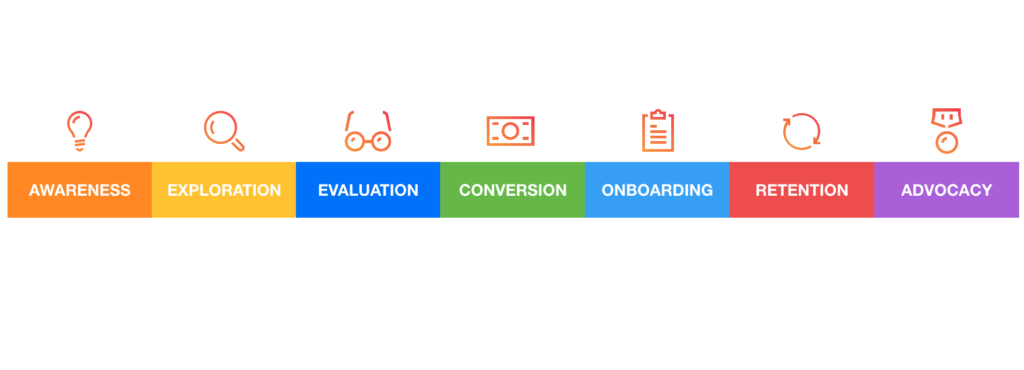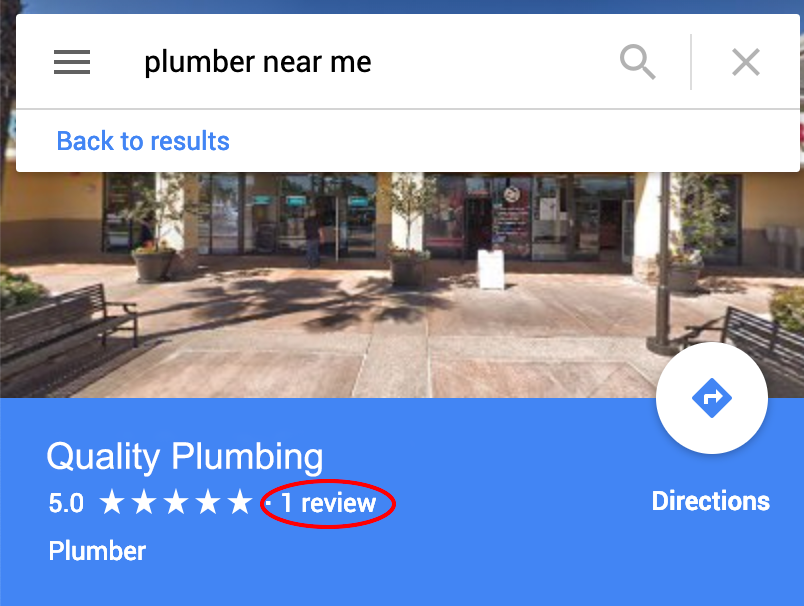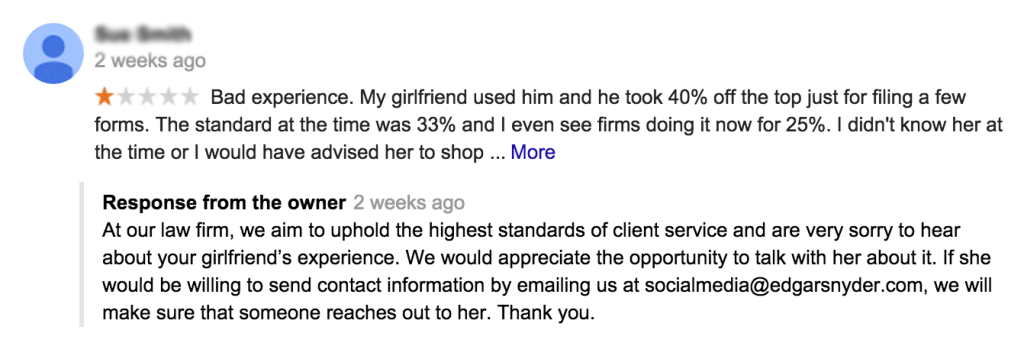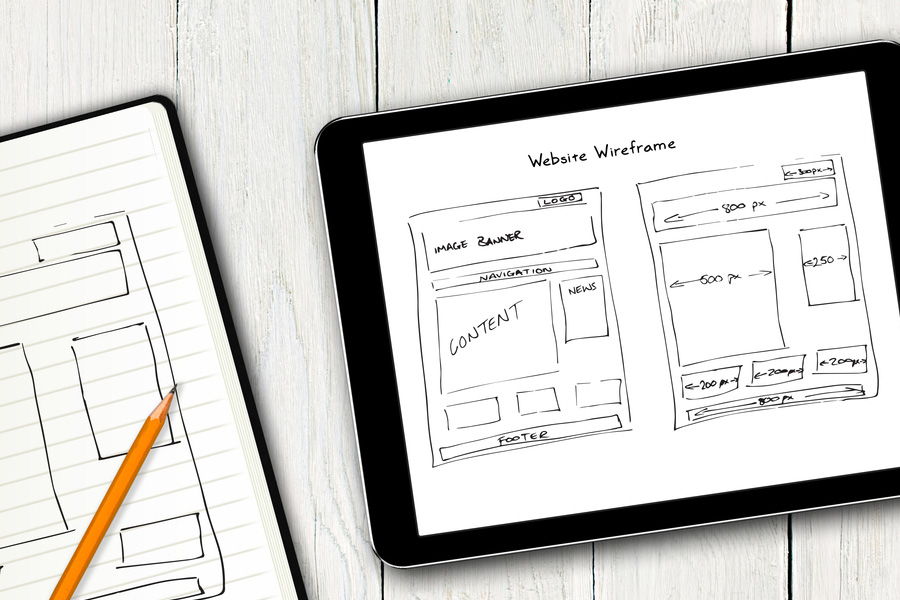 by: Jenn McQuade In: Digital Marketing
by: Jenn McQuade In: Digital Marketing
The importance of an effective landing page is not new. But it certainly seems to have gained more traction in the past few years as attention span continues to decrease, and content, choices and distractions all continue to increase across the internet.
In our last blog post, we gave a brief intro into CRO and why it’s an essential strategy to implement in your business. Below, we’re diving deeper into landing pages and Landing Page Optimization, as they are crucial aspects of your broader CRO strategy.
Creating an effective and properly optimized landing page can increase conversions – whether sales, signups, or otherwise. So let’s talk more about why you should use them, if landing page building software could be right for your business, what belongs on a well-performing landing page, and more!

Why You Should Be Using Landing Pages
As we just mentioned above, landing pages are an important part of the CRO strategy because they are one of the pieces of the puzzle you can use and continue to optimize in order to significantly increase your conversions.
Overall, they have been proven to be more effective than your website’s home page, and most other top level pages of your website, when it comes to actual conversions. This is because while most websites are used to tell everything about a business, share all products available, provide an entryway to blog posts, resources, social media widgets and more (which is not exactly conducive to holding your audience’s goldfish-sized attention span), a landing page does just the opposite. A great landing page is focused and singular-minded.
When designing a landing page, you should have one very specific goal you are trying to accomplish…without unnecessary links and navigation to other areas of your website…without other offers competing for their attention…without extra photos or content that distract from that one goal.
You should be using landing pages because they can be one of the best salespeople on your team. Imagine getting a sales call from someone spending time telling you about everything under the sun when it comes to their business, then quickly asking, “So, are you ready to buy?” Contrast that with one that focuses on the very best product or service for you, the features and benefits it will provide, stories of how it changed other people’s lives who are just like you, and even a limited time discount on that specific offer.
A website is still necessary for the big picture of your business, but effective landing pages are essential for converting visitors to leads or customers and especially when connected to strategies like your PPC and social media campaigns.

Should You Invest in Landing Page Software?
One of the reasons we believe the focus on high-converting landing pages has taken center stage more recently is the increase in user-friendly landing page building software. These have been created to, hopefully, simplify the page building process using CRO best practices (particularly if you use a pre-built template).
The way it used to be done, which is still a viable option for some, was to use your website’s standard page template to create a page that accomplishes your one specific goal, like we discussed above.
A few potential problems arise with this method. Creating a page from the ground up can be costly, depending on your website platform’s page building capabilities. Not all are simple drag and drop with clear containers set up for images, text, etc. It’s very likely you’ll spend time and money working with a designer and developer to get it built properly.
Another reason this isn’t our favorite way of building a landing page is because your website was most likely not originally built for one-page, conversion-focused content. To name just one example, your top navigation bar. This is, of course, necessary for navigating around your main website. But effective landing pages have very few links, and generally do not contain navigation. This is on purpose, to keep the visitor focused on the conversion goal at hand. So your standard page template within your website may not be as effective as building a page in a landing page builder.
Keep in mind, however, just because the software provides pre-built templates, doesn’t mean you won’t need some level of support or expertise at some point. While the drag and drop features are typically user-friendly, you’ll want to ensure the visual experience of the page still falls in line with the look and feel of your website and branding. It’s also important to use best practices for your imagery, CTA buttons, and conversion-based copywriting. (We’ve seen some pretty horrendous landing pages with terrible conversion rates when using landing page builders but without a knowledge of design and CRO.)
There are many options to choose from, at different price points, with differing levels of support, pre-built templates and ease of use. A few of our favorites are Unbounce, LeadPages and ClickFunnels. (Note: we have an affiliate account with ClickFunnels, should you choose to click on our link and start using the platform, but we use and recommend other platforms all the time because we believe different tools can be right for different client’s needs.) The tool you choose depends on what you’re trying to accomplish, whether you need built in follow up tools, and the past experience and preferences of your team.
Even as an agency with full custom design and development capabilities, using a landing page builder allows us to build beautiful and effective pages, keeping costs lower and passing those savings on to the client!
Never Stop Optimizing
It’s not enough to build a landing page, you also need to optimize it. I know, I know, is the job of a marketer EVER done? The answer is simply, nope! (and we’d say to be wary of anyone who tries to sell you a set-it-and-forget-it type of strategy…but I digress.)
Your newly built, beautiful landing page is hopefully part of a larger strategy to accomplish the specific goal we keep talking about. This means you won’t build a page and just hope someone stumbles upon it. No, you’ll use it as a destination for traffic, whether paid, or organic. And since you have a clearly defined goal, you’ll be able to understand whether or not that goal is being met.
Remember when I mentioned landing pages typically don’t have navigation links on them? Because of this, your landing page might be the only thing the visitor sees, making it very important to continue to optimize once you see if the traffic you’re sending there is converting.
A/B testing is at the heart of CRO, and good landing page builders have a level of A/B testing built right in. Assumptions you’ve made and questions you’ve had in the past regarding the best headline or call to action, or even button color are all elements you can let your audience decide rather than constantly guessing. It’s a very reassuring process. To not optimize would be wasting resources spent designing and building the page, as well as the resources spent driving traffic to it.
There are key components of an effective landing page, and it is important to A/B test these components, specifically, during your optimization process!
These are, in no particular order :
- An attention-grabbing Heading
- Conversion-focused subheadings
- Beautiful, high resolution and relevant imagery
- A compelling offer and how they will benefit from it
- One prominent Call to Action – (Remember, while there should be a main singular CTA, it should be repeated down the page no matter where they are while scrolling.)
Conclusion
While most people know about the importance of landing pages, we still see many businesses focusing their time and money on driving traffic. This is essential for getting eyes on your offer, but without a concentrated effort on building and optimizing landing pages, the chances of converting the traffic you’re spending money on will be significantly less.
So as you think through your business offerings now and in the future, remember landing pages and Landing Page Optimization are key tenets of an effective CRO strategy!
 by: Jenn McQuade In: Digital Marketing
by: Jenn McQuade In: Digital Marketing
It seems crazy to suggest – I can still boost my business during the time of Coronavirus?
While many businesses unfortunately haven’t been able to see the sales boosts they’ve needed recently, we want to share a few ways to boost your systems and marketing infrastructure. This way, once the economy begins to open back up, you’ll be more prepared than ever to serve your clients well.
As we all continue to social distance, and many of us are required to work from home, there are plenty of low-cost, low-barrier-to-entry ways to improve your marketing systems you can do from the comfort of your own home (or even couch!). These are things that seem to get pushed to the backburner during busier seasons, but now just might be the time to knock them out.
Let’s take a look at a few.
Develop An Email Series
Did you know that it takes an average of about seven touchpoints to convert a customer? This is why strategic email campaigns continue to be one of the most important ways to nurture a prospect from first touchpoint, all the way to conversion.
These email series are a great way to continue showing up in front of your customer (whether or not they open every email you send), offering value far more often than you are pitching or selling. They establish trust, give you credibility, and help to ensure when the prospect does need the product or service you’re selling, you’ll be top of mind.
You can choose to make the content timely to what’s going on in the world right now, or maybe you’ve had an email series idea for some time now that you can finally get to writing…one that you’ll have for the long run as part of your email marketing arsenal. Whether you have a simple, free Mailchimp account or a highly sophisticated marketing automation platform, you can write a relevant series of emails that build on each other to create one AWESOME marketing and sales tool.
An effective email series has, at minimum, three emails, but we recommend more if possible! And, when it comes to the content of these emails, remember Gary Vaynerchuck’s well-known adage and book title, Jab, Jab, Jab, Right Hook. A ‘Jab’ refers to offering valuable tips, ideas and information to your customer. It’s only after you’ve given that value several times that you should try to make your sales pitch, or, the ‘Right Hook’.
Note: With a free Mailchimp account, you cannot automate your entire series, but if you’ve written the content, it’s simple enough to automate each one individually to send at the appropriate time. There are plenty of other marketing automation systems out there as well at a wide variety of price points. We’ve become fans of Active Campaign. You can start small and add powerful automation tools without racking up a big monthly bill like some other options on the market.

Produce Thoughtful, Valuable Content
If Content is still King, then thoughtful, well-planned content might as well be the majestic crown that immediately lets you know this king is the real deal! Weird analogy, but give me a break, I’ve been quarantined for 35 days now 😉
There’s clearly no shortage of content out there, coming in every form, on multiple platforms, all day, every day. (Although, can we all agree that the memes being created right now by people getting cabin fever seem to be funnier than ever? Something to be thankful for, for sure.)
We always stress to our clients, “Please do not create content just for the sake of content.” It should have a clear goal, and that goal should be related to pain points you can help solve for your ideal customer. Some common goals for valuable content are to educate your audience, entertain, engage, inspire or convince them.
Know your goal before producing your content and the process will go more smoothly, and the outcome will most likely resonate even more with your intended audience.
Take this time to write a few blog posts that can be spread out over the next few weeks, creating a regular publishing schedule for your business (then try to keep it going!). You could also develop an ebook or checklist that acts as a valuable download in exchange for gathering new email addresses. Or, sit down in front of a clean background and shoot a few talking head videos to use in your social media.
Start planning topics, outline your thoughts, and then decide which medium would be effective and, most of all, doable for you during this time!
Develop your Customer Journey
If you’ve never sat down with the main stakeholders in your company and mapped out each phase of your customer journey, now is the time to do it! The customer journey informs the rest of your marketing strategy, tactics, and even the types of content you’d need to develop, so it is truly essential to your business.
We recently wrote a more in depth blog post on customer journey mapping and how it relates to CX (or, customer experience). Please take the time to check it out!

In that post, we discuss the seven stages of the customer journey, from Awareness to Conversion and beyond (yes, Conversion is definitely not the last stage of the journey!). In each stage, you’ll need to think through the perspective of your customer. This will allow you to develop creative ways to move this customer along, through each consecutive stage, in hopes of creating a raving fan for life!
Develop a Funnel
No matter the situation you find your business in, whether during a worldwide pandemic, or while it’s business as usual, every business greatly benefits from developing a digital, automated sales funnel.
What does this mean exactly? Well, let’s walk through a scenario.
You meet a prospect at a trade show, or you’re doing some networking on LinkedIn. They want to know more about what you do. And you don’t want to forget to follow up with them, because, they could be your next big sale!
You might hand them a printed piece of marketing collateral that explains who you are and what you do. You might even send them to your website so they can learn more about you. But let’s be honest, that piece of paper probably ended up in the trash by the end of the trade show (along with a hundred other brochures). And if they went to your website, I’m sure they were impressed! But they clicked around for a while, looking at your ‘About’ section, maybe some team photos, saw some products and then got distracted and may or may not have found their way back to that open tab again.
Now imagine, instead, you send them to a dedicated landing page. It’s beautifully designed, with just the right message that speaks directly to their needs, along with the solution you provide, and even a few testimonials about how you’ve solved this same problem for others, bringing them amazing success. It’s like leading your prospect into a room with just one open door to walk through rather than 10 doors leading them in every different direction.

Also on that page is not a hard sales pitch, but a valuable piece of content they can download by exchanging it for their email address. “The Top 3 Mistakes You Never Want To Make When Doing X” or “The Only 5 Things You Need To Know Before Making a Decision about Y”. (Maybe this is the Download you decided to write when we talked about creating valuable content above!)
Since this is the exact type of problem they’re currently dealing with, they submit their email address. This automatically triggers your follow up email series (again, could the email series you were already thinking about earlier in this post fit here…killing two birds with one stone?!) The series could include one email that contains their download, another couple that offer additional valuable information, and a third that gives them the opportunity for a free phone consultation.
By the time they get on the phone with you, they’ve had several touchpoints, you’ve become a subject matter expert to them, and the close will be that much easier.
And all of this was automated. The funnel – from landing page, to download, to follow up emails – is created and implemented once, and then runs automatically without you needing to set reminders to send follow up emails or offers.
If you’ve been thinking recently that you need a more effective website, you might actually just need some effective landing pages and funnel development instead! Check out our blog post on this topic, Why You Might Not Need a New Website.
Work On Boosting Your Online Reputation
One thing that has been so cool about this unprecedented time in history (if you can say anything is cool about this period), has been seeing people’s desire and willingness to support and help out other businesses. (Especially if you’re a small local business, but the sentiment seems to extend beyond that.)
Also, without daily commutes or after-work social functions, most of us have a little extra time to, for example, write a review or testimonial about a business we’ve had a great experience with in the past when things were normal, or even recently if you’ve still been able to conduct business!
Our latest blog post over at Fireworx Reputation discusses why reviews are going to be more important than ever coming out of this crisis. Be sure to check it out! (Hint: One reason is that customers are going to be more selective than ever about who they give their business to. Are you ready for that?)

While you probably shouldn’t be soliciting reviews from customers from two years ago, more recent ones that you never had a chance to reach out to would be a great list to email. A simple greeting and message, thanking them for their business and a review request is all it takes!
Let them know exactly where to do this, based on what makes sense for your business – whether it’s leaving a review on review sites or sending you a testimonial you can use on your website or in marketing collateral in the future.
*Note: Google Reviews is not currently fully operational, but will be again once the shut down period is over and there are plenty of other review sites that probably need your 5 star reviews.
So What Do You Think?
Could it be possible to take on just one of these marketing best practices while we’re still in the midst of this crisis? Maybe even two of them? Could an email series and some new content be part of creating an entire marketing funnel? There’s a lot of room to get creative here and you can get started with just one thing at a time!
Put some downtime into any of these ideas and we guarantee you’ll feel more prepared to market to and provide value to new and even current customers. We give you full permission to have Netflix on in the background as you tackle your strategy (or strategies) of choice!
 by: Jenn McQuade In: Digital Marketing
by: Jenn McQuade In: Digital Marketing
Your customer journey is hyper-specific to your business and is one of the most important things to clearly identify and develop. Not only as it pertains to marketing, but to your business strategy as a whole.
Great CX, or Customer Experience, is a non-negotiable. In the past few years, it has become a key differentiator between a brand and its competitors.
Providing top notch customer experience has to start with understanding the journey your customer is on, from even before they know who you are, to the moment they decide to purchase from you and beyond.
Why is Customer Journey Mapping so Important?
Salesforce defines customer journey mapping as ‘a visual representation of every experience your customers have with you.’ One reason customer journey mapping is so important is because of the impact it has on CX, or, Customer Experience. It’s contained right there in the definition!
Consider that a few years ago, the Customer Experience Impact Report found that 89% of consumers began doing business with a competitor following a poor customer experience. Customer expectations are higher than ever and we wouldn’t be surprised if this percentage continues to increase going forward.
The lifeblood of your business literally depends on your customers having a great experience with you, and mapping your customer journey allows you to ensure great CX throughout their entire relationship with your company.
This is Not One-Size-Fits-All
Depending on your business and the language you want to apply to your customer journey mapping, there are a few different approaches to identifying the stages of your customer journey.
At its most basic, we’ve seen the journey boiled down to 3 stages – Awareness, Consideration and Conversion.
While these can provide a great starting point, often times, even for a simple business, the journey is more complex. So we like break those stages out even further.
Remember, it’s not one-size-fits-all, but the stages shared below will give you the framework to begin developing your customer journey map.

An Overview of Customer Journey Stages
It’s important to note, the timeline for the journey is different for every business and every customer. For example, the larger the purchase, the longer it may take for a customer to go through each stage.
Additionally, not every customer will go linearly, one by one, through each of these stages, but for all intents and purposes, the journey you define using the stages below will be the most logical path.
Awareness
This first stage takes you back to before a consumer even knows who you are. It aims to find the trigger point that will lead to this person becoming aware of you.
How does the individual discover their need for the product or service you provide? For example, if you sell car insurance, the trigger point for becoming aware of their need would probably involve the consumer in the process of buying or leasing a car.
Exploration
After they become aware of their need, the consumer usually goes through an exploratory phase. Here, they are starting to do some research into you and your competitors. They may follow you on social media or sign up for your emails. But remember, they are most likely doing the same with your competitors.
Evaluation
Here, the prospect is more seriously evaluating their options, potentially getting a quote from you or wanting a demo of your product or service. They may start to narrow down their options based on any number of touchpoints they’ve had with you so far. Are you providing them with value and giving them peace of mind about the type of business you are? These are the things that create trust between you and a potential customer.
Conversion
The prospect has now decided from what they’ve experienced and researched, that you are the company they’ll choose. Congrats! This stage focuses on such things as ease of transaction, etc. Have you made sure the process to buy from you is as frictionless as possible?
Onboarding
The stage after conversion and before retention is not always broken out on its own, but we think it’s important enough to be its own stage! It might not be called ‘Onboarding’ for your business, but just think of it as the first interactions a customer has with you or your product after they have converted.
It’s the moment in the customer journey where you really need to ‘WOW’ the customer, so they don’t have buyers’ remorse and so they easily move into the next stage. An exceptional onboarding (or first-time) experience can mean the difference between a long-term successful relationship with a customer or a quick churn.
Retention
From there, the goal is to create retention or repeat buyers. What do you need to provide to this customer if they are going to consider buying from you again in the future, consider retaining your service month in and month out, or use your App regularly?
Advocacy
The ultimate goal for every business is to reach even more people, and since consumers tend to trust their peers even more than what a business advertises about itself, you need to turn each customer into a raving fan. In this stage, you’ll explore how you can encourage your new loyal customer to tell their friends and family about you, such as offering incentives for each referral they bring to you.
You’ll also want to provide friction-free ways for them to spread the word about you over social media or through online reviews to reach even more potential customers!

Customer Journey and CX, Intertwined
As we already discussed above, CX and customer journey mapping are completely intertwined. For every stage of the journey, there are opportunities to focus on exceptional Customer Experience.
In each stage, you’ll identify things such as your desired customer behavior within that stage, the problems they are facing, the goals they are trying to accomplish, and what they are currently thinking and doing in that particular stage.
These are largely assumptive at first, but through research, talking to real customers, and developing your buyer personas, these assumptions become evidence-based.
Additionally, for each stage you’ll map out how you will interact with the customer, the value you can provide, and tactics and technology needed to reach the customer effectively so they take your desired action.
The end goal is to know exactly what marketing you need for each stage of your customer journey, and how that marketing tactic meets the needs of your customer. This way of strategizing your marketing goals and tactics is highly effective whether you are a large, multi-national corporation or a small local business.
Take email marketing, for example. We all know email marketing is an important marketing strategy. But what’s less understood is how this one type of marketing can be applied across the journey, and how different it looks at each stage. There are nurture emails, transactional emails, onboarding emails and so much more! Each type of email at each stage is a chance to provide value and an excellent customer experience.
Conclusion
Delivering great customer experience at each stage of the customer journey is key to your success. Without it, a prospect quickly realizes they have other options, who are just a quick Google search away.
Many companies (or even other marketing agencies!) want to jump right into tactics they think will work because it seems to be working for others. But it is crucially important to start with a smart and well-developed strategy that considers each stage your potential customer will find themselves in.
This way, you can anticipate how to be the ones to fulfill their needs, give them an amazing customer experience, and create loyal, raving fans of you and your business.
 by: admin In: Digital Marketing
by: admin In: Digital Marketing
Your business’s reputation is everything. Not only is it how potential customers are finding you, it largely influences whether or not they’ll give your business a chance. Having a beautiful website and social media posts that speak to how great your business is doesn’t carry as much weight as when your customers are the ones sharing their experiences, particularly if that includes a negative review.
The more you focus on building your online reputation, the better off your business will be in both the short and the long run! A higher quantity and frequency of reviews means higher credibility which ultimately means more clicks for your business. The flip side to focusing on gathering more reviews, however, is that the more reviews you get, odds are you WILL receive a negative review once in awhile. But we’re here to tell you it’s not the end of the world! Or, at least it doesn’t have to be if you’ve been building a solid reputation.
So, when is the worst time to receive a negative review, and how can I avoid that scenario? How can I respond to a negative review appropriately? What’s the best case scenario for a resolution of a negative review? We’re answering all of these questions below, so let’s get into it.
When is the worst time to receive a negative review?
At first, you might think, “Always! Why would I ever want a negative review left about my business?” Ok, sure, we aren’t saying you should be hoping for a negative review. Our point is that in a lot of scenarios, a negative review doesn’t mean you should panic, but there is a particular scenario where a negative review is a huge cause for concern — when you have very few total reviews.

It’s a game of averages when it comes to your overall star rating. Someone with dozens and dozens of positive reviews can get a terrible, 1-star review and it will hardly make a dent in their overall rating. Although you should still respond to it (as we’ll discuss below), your overall score will bounce back quickly. But having just a few reviews and receiving a 1-star review will drop your rating significantly, forcing you to go into damage control. It will take multiple new positive reviews to help make up the difference. Don’t ever find yourself caught off guard in this type of situation!
Avoiding that situation comes down to being proactive about gathering new reviews consistently, and engaging with those reviews, so consumers know you take their experience seriously.
How to respond appropriately to a negative review
Although human instinct is to fight back against someone who is attacking you (in this case, a verbal, online attack), it is of utmost importance that you don’t fire back in defense, or try to turn it on them for why they had this poor experience.

It’s very possible that this review was not warranted. That their perceived negative experience was actually the result of something they did. Whatever the reason may be, you’ll follow the the same guidelines to respond in a way that diffuses the situation rather than escalating it into a back and forth comment war on the review site for everyone to see.
Step back for a minute
The first thing you need to do is to take a moment, a few hours, or even a day (but not much longer than that!) to make sure what you respond with isn’t coming from a defensive or emotional posture.
Be kind & apologize
As you’re crafting your response, make sure you are being kind, apologetic and understanding of their feelings. You don’t need to fall on your sword necessarily, but you can easily disarm someone by letting them know you’re sorry they had this experience and that you understand their frustration. People want to feel heard, and letting them know that can help bring their anger or their guard down.
Get honest about your business
Now this next suggestion is something you can only implement if you actually believe and have seen it to be true about your business. We like to apply the old saying, “You can’t put lipstick on a pig,” to businesses that want to take their reputation seriously. If you have bad business practices, horrible customer service and/or a terrible product, focusing on reviews ultimately won’t help you. The truth WILL come out.

However, if the details in this negative review actually aren’t the norm, you can acknowledge that in a way that builds your business up (rather than tearing the reviewer down!). Something along the lines of, “We take pride in our ability to provide excellent service and a happy customer experience, and while it sounds like we didn’t get it right this time, we hope you’ll let us try to win you over!”
Take it offline
Finally, offer to take the situation offline by providing contact information for someone who would be happy to talk it through with them. Like we mentioned earlier, you don’t want to start a negative comment thread for the whole world to see. As much as this interaction is between you and an unhappy customer, it is also an advertisement to anyone else looking on about the experience they might be subject to if they choose to do business with you. Let’s make sure they see it will be a positive one!

What happens next?
Every situation is different, but there are a few things that could happen next.
The best case scenario would be the reviewer modifying or updating their review to reflect how their situation was dealt with in a positive way. They’re giving your business a second chance, but are also essentially advertising for you with this update. You just turned a negative situation into a positive, money making experience. This is why you should ALWAYS follow up on a poor review, no matter what!
Alternatively, the issue might be cleared up, but the review will not always be updated. Don’t be surprised if this is the case! They may not be holding it against your business anymore, but they just don’t feel compelled or motivated to go back through the process.
As long as you followed our guidelines for how to respond to their negative review, anyone who sees the interaction will most likely give you the benefit of the doubt because you took the time to respond in a rational, sympathetic way. You’ve humanized your business, and that goes a long way with people! Also, if you’ve been taking your reputation management and marketing seriously, you know that there are dozens of other positive reviews that will make this one almost obsolete.
Put yourself in your customer’s shoes
You can’t go wrong if you take the approach of putting yourself in your customer’s shoes when it comes to all-things-reputation. Chances are, like your potential customers, you check out Google or Yelp reviews before staying at a hotel or using a new auto mechanic. Think about what you want to see before committing to visiting a new business. Similarly, if you leave a negative review, how would you want the business to respond to you? Most likely, you’re looking for an understanding response and an effort to make things right.

By following our guidelines above, learning from each experience and building up your overall rating, a negative review will just become a tiny bump in the road as you outshine all of your competitors!
Interested in quickly building your reputation, but think you don’t have time to add hours a day onto your already full plate?
Check out our automated, do-it-all-for-you platform that will help you achieve your rock solid reputation.
 by: admin In: Digital Marketing
by: admin In: Digital Marketing
“You might not need a new website.” There, we said it.
As a digital marketing agency, whose portion of their business revolves around developing websites, writing this post almost feels like blasphemy. Don’t misunderstand us, we feel strongly that there is a basic, essential need for every business to have an effective website.
(Disclaimer: If your website hasn’t been touched in a number of years, you probably do need a new one. There’s a lack of credibility that unfortunately comes with having a completely antiquated website.)
Pretty pictures don’t equal conversions.
But we’ve come across many businesses that feel the need to redesign and redevelop their website just because it isn’t being the top salesperson for their company they thought it would be, or because they don’t feel it’s the most cutting edge version it could be. They want the most current design, a whole new look and feel, and maybe if they just showcase more of their personality on the site, people will pick up the phone and do business with them.
Right?
Well actually, no, that’s usually not how it works.
Unless you’re one of the 22% of businesses that are satisfied with their website’s conversions, you’re looking for more. And if that’s the case, a ‘prettier’ version of your website won’t always be the fix. What you need is a funnel.
While a website may aim to accomplish many goals, a funnel has one goal: to convert visitors on a specific offer.

Focus is key.
Ever heard of “voluntary simplicity”? While things like minimalism and capsule wardrobes may just sound like a trendy millennial movement, there’s actually something to it. Having less choices, less clutter and fewer things vying for your attention naturally leads to less stress, can make people happier, and (what we’re most interested in) allows the individual to be more focused. Focus is key when it comes to someone sticking around on your site long enough to realize the true value you have to offer and to take action on one specific thing.

Picture this: A prospect arrives at your website. Their eyes scan the screen. There’s a top navigation menu that can take them a dozen or more places right off the bat. They might decide to learn more about your company or the many products or services you offer. They’ll take note of how easy (or difficult) it might be to get in touch with you. Now they’re distracted by the beautiful photos of your team, checking out upcoming events, reading blog posts, etc. Not to mention the countless other links to social platforms, special offers and more, begging for just a moment of their short attention-span.
Your first thought might be, “Wow! I would love to have a visitor checking out every page of my website and learning more about who we are!” And if your goal was just for a prospect to know about you, it would be a success. But a real conversion would be much more valuable. We want to see a specific goal accomplished; whether it’s a form fill, email submission, phone call, or maybe even a purchase.

Limit choices, increase conversions.
By limiting people’s choices, you’re actually increasing your conversion rates. We looked at multiple studies on removing header navigation done by Hubspot, Yuppiechef, Career Point College, SparkPage and more, and while percentage of increase varied, it was still always that – an increase. Hubspot’s increased percentages on middle of funnel content, such as a demo or free trial showed as much as a 28% lift in conversions. Yuppiechef and Career Point College both increased conversions by 100% and more!
The beauty of a funnel is in its simplicity, focus, and sophistication. As opposed to walking your prospect into a room with 100 doors and asking them to choose one to walk through (like your website is doing), when someone comes into your funnel, you are walking them into a room, and in that room they have just one door to walk through. The choice is simple! They can take a specific action, or leave.
Fortunately, even if they choose to leave, it doesn’t mean you’ve lost them forever. Because, retargeting. And while it’s true you can retarget from your website as well, the fact that your funnel is so specific means you can segment this visitor as having an interest in that very specific area of your business.

No ‘spray and pray’ marketing, just marketing that works.
Your marketing strategy becomes laser focused on those who are actually interested in what you have to offer when you take the funnel route. And the most exciting part is that implementing your funnel can simply be a matter of integrating with your current website and marketing systems.
One day, you will have to spend your marketing dollars on a brand new website. But we’re here to tell you, that day might not have to be today. Our advice is to create a system that funnels your audience into a specific offer, where you have a higher chance of conversion, and then follow up with them until you make the sale. Bonus points if this system is largely automated!
Now THAT’S effective, time and money saving marketing. And that’s something we can all get behind.

 by: admin In: Digital Marketing
by: admin In: Digital Marketing
Reputation is everything. For 83% of consumers, what people say about a business is more important than what the business says about itself. (Nielsen) For local, service-driven businesses, this is especially important as 86% of consumers would pay more for a service from a business with higher ratings and reviews. (BrightLocal)
Managing your business’s online reputation is a lot of work, but even with the limited time that local business owners have, there are a few great places to start—some low-hanging fruit so to speak. We believe that these are the most effective and important areas to focus on first when it comes to managing and marketing your business’s online reputation.
Ask for reviews.
Ask yourself which of the insurance agencies below you’d have more confidence in hiring:

They both have five stars, but when it comes to online reviews, it’s not just about the amount of stars you have. It is important to have many positive reviews. Not only does this give consumers more confidence in your business’s ability to meet their needs, it also protects your online reputation from being tanked by one negative review.
The way to get more positive reviews is simple: ask! We see a great increase in amount of reviews simply from asking. And if this process is quick, easy and automated after a purchase or completed appointment, even better!
Respond to reviews.
It’s very important to keep track of reviews as they come—positive or negative—and respond. It’s encouraging for customers to be thanked for positive reviews, and it’s especially important for businesses to reply to negative reviews quickly and professionally.

If handled well, a negative review from a poor experience can be turned around into a positive experience for the customer. Not only can you work through a solution before it becomes a bigger problem, you can also do this in a public forum where other potential consumers will see that your business cares about customer service.
Promote positive reviews.
You’re good at what you do and it’s important for people to know that! Be sure you share the positive reviews that your business is receiving on other review platforms, on social media, your website, landing pages, and on print material and let your happy customers do the selling for you. When you share these positive reviews on social media, just make sure that you are spreading them out over time and mixing them in with other content.

Remain FTC and ISO compliant.
An effective reputation marketing strategy can take dozens of precious hours a month to execute. From monitoring the many review sites out there, to asking for and responding to reviews, some decide that managing and marketing their business’s online reputation isn’t a top priority, which is understandable! It’s easy to make excuses for a lack of investment in marketing, especially when your job is already pulling you in a thousand directions.
In this case, many people decide to turn to services and platforms to do it for them. A very smart move, but only if you know exactly what practices are used to garner reviews. Unfortunately, a lot of solutions out there use processes called ‘gating’ and ‘filtering’, essentially meaning they ensure a positive review will be received before the customer is officially allowed to even give one. This is an illegal practice and up until recently, a lot of people were getting away with it. Now it is being more strictly enforced, and many businesses have been penalized because of it.
Conclusion
With review platforms today being considered the new word-of-mouth, your business can’t afford to not be the one people are talking about. You may not receive all 5 star reviews, but guess what? An average score of 4.8 or 4.9 will be just as trustworthy, and consumers will know your business is getting real, honest feedback from people in every kind of scenario. But it’s important to put some resources into this aspect of marketing…to give every customer the opportunity to review, to follow up on all reviews (especially negative!), and promote the positive all while following the rules. It just might be the biggest (and quickest) bang for your marketing buck you could hope for!

 by: admin In: Digital Marketing
by: admin In: Digital Marketing
Believe it or not, Pay-Per-Click advertising is one of the best marketing investments you can make today. Consumers go to Google when they want to know, go, do, or buy something. That means, when leveraged correctly, your business, product, or service can appear before the eyes of a consumer who is itching to convert. However, many businesses still aren’t taking advantage of Google Ads.
Here are four common excuses we hear from those who aren’t making this marketing investment:
“Google Ads is too expensive.”
Yes, it is an expense, but businesses make an average of $2 in income for every $1 they spend on Google Ads. When done correctly, these campaigns can be worth every penny.
“I have an SEO campaign.”
Not only can you see the benefits of Google Ads more quickly than SEO alone, but Google Ads visitors are 50% more likely to purchase something than organic visitors. These campaigns compliment SEO very well and can even help you dominate all search results above the fold.

“No one clicks those.”
Actually, they do. Over 45% of people couldn’t identify paid ads on the search results page and the top 3 sponsored spots get 41% of the clicks on the first page of search results.
“I already tried it, it didn’t work.”
When done well, a Google Ads campaign can be highly effective. First, assess things like your ad copy, the landing page your prospect is taken to, keyword categories and negative keywords lists. Then, make the necessary adjustments to help your campaign run more effectively.
In the end, Google Ads is one of the best tools for lead generation—one where you can see fast, measurable results. 80% of search results now yield Google Ads. And these ads take up 85% of the space above the fold. That means it’s time to stop making excuses.
It’s time to put your money where their search is.
 by: admin In: Digital Marketing
by: admin In: Digital Marketing
You can’t be all things to all people.
You’ve heard the old saying, but do you practice it when it comes to your business? Whether you are selling a product, or providing a service, there are going to be certain types of people that are more likely to buy from you than others. So focus on them. You want these ideal customers to think of you when they need what you provide, but are you thinking of them in the meantime?
Using proven research methods, including how you will segment your audience, then conducting in depth interviews (IDI’s) and persona interviews is the surest way to get accurate data for your buyer personas. Whether you are a B2B or B2C company, the takeaway is the same – taking the time to create and utilize buyer personas is the most powerful way for you to truly understand your customers – their needs, their pain points, and how you can make their lives better.
While the subject of buyer personas goes incredibly deep, we want to focus this post on 5 reasons why buyer personas inform your business.
1. Know where your customers spend their time
…so you can be there, too. Hear us out, though. Please don’t bombard your customer with annoying sales pitches on every channel they utilize. You don’t even need a buyer persona to tell you that, because, nobody wants it.
But do let it inform things like what social media platforms your persona prefers, so you can be there to provide relevant, useful information through that avenue. By conducting research and talking to your current customers, you may find that they never even open their Instagram account, but have LinkedIn running in the background all day long. You can then put the appropriate resources into building your LinkedIn presence instead of just dipping your toe into all social platforms.
It can also inform the places that would be most beneficial to place ads, because they have a higher probability of visiting one website over another, or reading one magazine over another, etc.
2. Create content with a purpose
If you write it, they will come…said no one ever. Producing content for the sake of content will end up frustrating everyone involved. It also won’t give your marketing team a win in your company’s eyes.
On the other hand, having well-developed buyer personas will give you insight into exactly who you are writing to so they are more likely to resonate with your content when they read it. Remember all of those categories you focused on when developing your personas? Well, this is where they can really come into play.
What are your persona’s biggest pain points? You can now create a blog post for each pain point. Include solutions in these posts, particularly how your company can help. Have a new customer? Develop a series of emails to be sent that will help to onboard them and give them tips and tricks for how to be successful using your product or service. Maybe you’re aware of what would make your persona’s life easier. Create an infographic with 20 things they can do to achieve that goal.
Now let’s take that a step further, remembering that you also know where your target personas spend their time, as we discussed above. Imagine a targeted ad appearing in front of your persona leading them to an article that offers a solution to the exact kinds of problems they’ve been trying to address. This is where you go from just another company pumping out content, to a trusted partner helping them achieve their goals.

3. Build a website that works hard for you
Setting out to build or rebuild your company’s website can seem like an incredibly daunting task. There are countless agencies vying for your business, but clearly they are not all created equal. Not all agencies know how to properly use buyer personas to inform your website development.
A great, effective website will address the motivational drivers of each persona. In some selling situations, personas might be based on role. For example, marketing managers vs. marketing directors vs. business owners, each with different motivations for buying the same product. In another case, you may find personas driven more by attitude than role, ie strategic, financially or technically-driven buyers. The type of design, the images you choose, and your text and calls to action should specifically appeal to your personas.
4. Create the product your buyer wants
Done right, personas will inform more than just your marketing department. An area greatly affected by properly developed personas tis the product development department. Personas provide insights to your development team about who they are selling to, who they are creating for, who they are constantly working to attract and retain as loyal customers.
Just about every product in the world will continue to evolve over time, to become more useful and to stay relevant to its users. The personas you have already created, as well as having built a culture of communication with your customers, can be invaluable as your product development team looks to improve. You are able to provide them with clear wants and needs, as well as feedback on what might not be working or valuable to the user.
This is also a good time to mention that buyer personas not only come from talking to your customers. They are also the ones who didn’t end up buying from you. Their opinions can be some of the most important because you can save countless other prospects from slipping through the same cracks. Again, you can never be all things to all people, so for some it might just not be a good fit. But whether it was a hole in the sales process, or because your product didn’t have a certain critical feature, this type of information can serve your company well.

5. Bring in qualified leads
Speaking of the sales process, buyer personas can easily become your sales team’s best friend by increasing the amount of qualified leads versus unqualified leads coming across their desk.
If your personas are being used to their fullest potential, you might see a scenario like this:
The process of creating the buyer persona has informed product development, now making it the ideal solution for your prospect. You have written an ebook outlining the persistent problems facing the persona and how those problems can easily be solved. After creating and placing a targeted ad on your social platform of choice, your prospect downloads the ebook, resonates with the problem and is excited about the solution.
With all of the information that’s available with just a single click, most people do their research and read reviews ahead of time. They only really want to connect with a salesperson when they are ready to buy. So let’s look at the scenario above. As soon as the prospect decided to download, the power of person-driven marketing automation takes over. It nurtures your lead through the sales funnel, with content that engages, educates, and removes barriers in the buying process. By the time this person gets to a decision point, or talks to a salesperson, they are already informed about who you are and how you can help them. This makes the sales team’s job much easier…finally, marketing and sales REALLY working together!

Conclusion
We’d go so far as to say your marketing strategy should begin, first and foremost, with creating buyer personas and mapping the customer journey, using research and data tools. Buyer personas are all about getting into the minds of your customers, so you can truly understand them and their buying behaviors, and then serve them in the best way possible.
By taking the time to talk to your current or past customers, or those who chose not to become customers, you will be able to develop a strategy across every area of your business that can attract and engage a prospect through their buying decision, and then nurture that customer relationship long into the future.
 by: admin In: Digital Marketing
by: admin In: Digital Marketing
Fireworx Digital just completed a full branding, website and collateral development project and launched this innovative new cloud technology company. Here is the press release that went out this morning…
Cloud-delivered software suite allows lenders to slash IT and office expenses and run an entirely paperless mortgage business – including loan processing, customer relationship management (CRM) and integrated telephone communications – in a secure, centrally-managed virtual environment San Francisco, CA (PRWEB) July 14, 2011
Acris Technology, formerly Acris Solutions, a software development company and provider of paperless technology for mortgage bankers and lenders, today unveiled Mortgage VCO, an end-to-end, cloud-based “virtual corporate office” suite of software applications, IT and consulting services that enable any mortgage lender to run a compliant, scalable, paperless mortgage business without the expense and complexity of on-site servers, software, maintenance and upgrades. The announcement was made at the 39th Annual Western Secondary Market Conference in San Francisco.
Developed and refined over a period of 12 years, Mortgage VCO had been in use privately for years by Laguna Hills, California-based Millenia Mortgage to process over $10 billion in funded loans and is now available to mortgage bankers, regional and community banks, credit unions, and other mortgage lenders. Mortgage VCO’s suite of solutions includes cloud-delivered virtual desktops, sophisticated loan origination and processing software, paperless document storage, digital signature technology, IP telephony, and mortgage-specific consulting and IT services. As a virtual, cloud-based office solution, Mortgage VCO drastically reduces lenders’ IT costs so they can focus on what matters: closing more loans in less time. It also removes all geographical boundaries from a lender’s hiring criteria and integrates all communications among all parties – including emails and phone calls – into the mortgage production process, enabling ultimate transparency and accountability within a lender’s operations. Lenders simply need a high-speed Internet connection to run Mortgage VCO.
“The enormity of the changes sweeping through the mortgage industry is having a fundamental effect on how lenders do business,” said Richard Johnston, president of Acris Technology. “If there was ever a time to reinvent the mortgage office, this is it. For the first time, lenders can have one office solution that does everything they need it to do and more – including a completely integrated communications platform that provides total control over leads and call campaigns, and the ability to run an entirely paperless operation. Simply put, Mortgage VCO makes lenders’ lives easier and more productive.”
The Mortgage VCO suite begins with the VCO Desk platform, which delivers a Windows desktop environment to any computer, laptop, thin client, iPad or tablet PC with a high-speed Internet connection. VCO Desk also includes the Microsoft Office® suite and MS Exchange® Server. Any third-party or proprietary software can also be hosted and delivered through VCO Desk’s secure Citrix® environment. Each of the five separate components described below can be added individually or together as part of the integrated suite:
VCO Lend – Loan origination and processing software that lets lenders enjoy increased productivity from their sales and processing teams, get real-time visibility into their operations and staff, reduce errors and ensure complete, compliant loan files. Designed for a compliance-driven marketplace, VCO Lend features highly-advanced task parsing and file queuing technology, custom rules-based workflow management, real-time performance reporting, incentive-based compensation, lead tracking and distribution, and comprehensive secondary marketing tools. VCO Lend allows multiple people to collaborate on the same file at the same time, improving turn times from application to funding. VCO Lend is packed with features yet can be fully customizable to a lender’s unique business needs.
VCO File – An easy-to-use paperless document management and hosted storage solution that integrates seamlessly with VCO Lend and other loan origination systems, VCO File saves time, money, and eliminates the need for on-site servers and file cabinets, enabling instantly-searchable digital file sharing anywhere, anytime.
VCO Sign – A digital electronic signature tool that uses public key encryption to ensure security, turbo-charging a lender’s pre-disclosure and document signing processes.
VCO Link – Provides seamless integration links with a variety of title, escrow, flood, credit, appraisal management, compliance and other settlement service providers – plus the ability to integrate with most pricing or automated underwriting engines.
VCO Voice – Based on IP-PBX technology, VCO Voice integrates call center phone service capabilities into the mortgage production process, with features such as a CRM-driven dialer that provides click-to-dial capabilities directly from a borrower’s file and the ability to have a borrower’s loan file appear on the loan officer’s screen when the borrower calls. Integrated call reporting ensures company-wide accountability and performance monitoring.
Mortgage VCO also provides a full range of integrated IT, technology and managed services, infrastructure support, customer training, and software customization, all tailored specifically to mortgage lenders. Mortgage VCO was originally developed by Millennia Mortgage, which has been processing loans in a paper-free environment since 2003. Acris Technology was founded to market the continually-developing proprietary software technology to the industry.
“It’s important to understand that while Mortgage VCO is new to the market commercially, it is a tried and proven platform that benefited from full-time developers and mortgage banking professionals, working side-by-side for many years – with innovation and process improvement as two of our primary core values,” said Martin Williams, CEO of Acris Technology. “We believe it’s the ultimate complete office solution for mortgage lenders that want to minimize overhead costs and IT complexity, increase efficiency and improve business processes.”
For more on the Mortgage VCO story, visit http://mortgagevco.com/our-story.
About Acris Technology
Founded in 2005 and headquartered in Laguna Hills, California, Acris Technology is a technology provider offering custom software development and a full range of IT services and infrastructure support. Its flagship product, Mortgage VCO, is a virtual corporate office solution that provides all the necessary software and tools to run a completely paperless, cloud-based mortgage office, enabling clients to realize increased productivity, shorter loan life cycle times and reduced expenses. The virtual suite includes loan origination and processing software, paperless electronic document management (EDM), digital e-signature tools, IP telephony, virtual desktops with Microsoft Office® and Outlook®, plus software customization and development services, IT, telephony and Citrix® virtual office consulting. For more information, visit http://www.mortgagevco.com.
 by: admin In: Digital Marketing
by: admin In: Digital Marketing
Fireworx Digital recently launched a new ecommerce web site for internationally recognized sportswear and fishing tackle company AFTCO Manufacturing, located in Irvine, CA.
For the first time, customers can make direct online purchases from the entire AFTCO fishing clothing line, including fishing shorts, shirts, pants, gloves and more. In addition, the site features a comprehensive catalog of AFTCO’s world famous hardware, including AFTCO roller guides, rod parts, gaffs, fishing harnesses and fishing belts, outrigger clips, Unibutts, and much more. These tackle items are not available for sale online, but each item includes a direct link to a dealer locator for finding retailers in a visitor’s local area.
The site is built on the Searchfit ecommerce platform, a favorite of ours here at Fireworx Digital, based largely on it’s extremely SEO-friendly architecture. Also included are a video blog, a dealer locator database for both clothing and tackle lines, and additional information pages featuring AFTCO’s unique technology that contextually tie back to each product. In addition, the site tells the story of AFTCO’s colorful history, including founder Milton Shedd’s founding of Sea World, and many other major ocean conservation efforts over the last several decades.
The AFTCO.com online store is the third site built for AFTCO Manufacturing. Fireworx previously designed and built online stores for GuyHarveySportswear.com and AlAgnewSportswear.com, two of AFTCO’s licensed product lines. As with the two previously developed sites, AFTCO.com is fully integrated with the company’s ERP software, Full Circle, which enables near real-time, two-way flow of pricing and inventory data between the two systems, as well as providing order and shipping information exclusively through one interface, familiar to employees at AFTCO.
 by: admin In: Digital Marketing
by: admin In: Digital Marketing
Fireworx Digital just launched a new online store for GuyHarveySportswear.com This innovative line of fish art clothing and accessories with over 7,000 styles and sizes has seen incredible sales growth not only among it’s loyal salt water fishing fans, but also among university students at campuses across the country.
The site was designed with a primary focus on extending and promoting the Guy Harvey brand. It provides one online location where Guy Harvey fans can see the entire line of Guy Harvey clothing items. A dealer locator makes it easy to find retail locations within a given zip code.
Fireworx selected SearchFit as the shopping cart platform for client AFTCO Bluewater, master license holder for Guy Harvey Sportswear, based largely on the fact that it was built from the ground up for maximum search engine optimization. Together with SearchFit, Fireworx was able to deliver a cost-effective, turnkey eCommerce solution for the new consumer direct site. The shopping cart was fully integrated into AFTCO’s existing ERP system, provided by Innovative Systems, LLC.



































